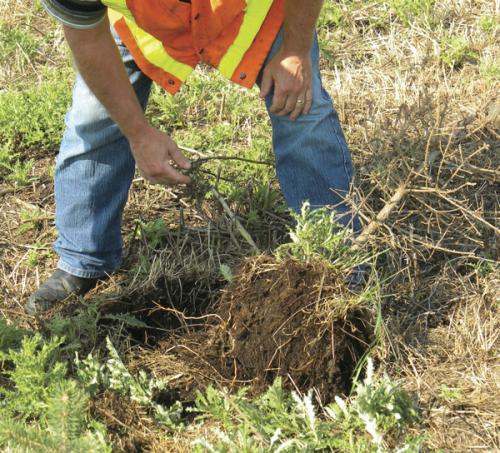November 29, 2013
Getting to the root of tree stress along highways
BY DR. DARBY McGRATH, RESEARCH SCIENTIST FOR NURSERY AND LANDSCAPE ANDJASON HENRY M.Sc., RESEARCH TECHNICIAL FOR NURSERY AND LANDSCAPE, VINELAND RESEARCH AND INNOVATION CENTRE
It is no secret that urban ecosystems are expanding across Canada. Readers of this article have likely observed many changes in the landscape, probably due to urban, suburban or exurban sprawl — often at the expense of a greener, more natural landscape. Growth to meet the demands of an expanding population has cleared plenty of land, particularly in the last five or six decades. There is need for green infrastructure now more than ever, to address both aesthetic and ecological objectives, including the heat island effect, carbon sequestration and water retention capacities.
 There are some practical challenges to installing green infrastructure in Canada: namely, how can we get plant material to survive in less-than-ideal, or harsh, conditions? Many of these green infrastructure plantings, be it a green roof, boulevard planting or multi-lane highway, present obstacles to the successful transplanting, maintenance and longevity of live material. This is why Vineland Research and Innovation Centre has embarked on a research journey that will tackle these challenges in conjunction with Ontario Ministry of Transportation, Landscape Ontario and Canadian Nursery and Landscape Association. The research program on highway roadsides and right-of-ways is focused on developing a system of establishment and survival for extreme environments, that can then be applied to many different types of green infrastructural plantings with greater certainty of the success.
There are some practical challenges to installing green infrastructure in Canada: namely, how can we get plant material to survive in less-than-ideal, or harsh, conditions? Many of these green infrastructure plantings, be it a green roof, boulevard planting or multi-lane highway, present obstacles to the successful transplanting, maintenance and longevity of live material. This is why Vineland Research and Innovation Centre has embarked on a research journey that will tackle these challenges in conjunction with Ontario Ministry of Transportation, Landscape Ontario and Canadian Nursery and Landscape Association. The research program on highway roadsides and right-of-ways is focused on developing a system of establishment and survival for extreme environments, that can then be applied to many different types of green infrastructural plantings with greater certainty of the success.Compaction kills urban trees
The very nature of highway planting sites makes them challenging from a soil systems perspective. Indigenous soil is often removed during road construction and repair, and mixed fill is returned to the sites in its place. The soil found at most modern urban development areas is comprised of poorly drained clay soils with characteristically small particle sizes. The heavy machinery used for road construction compacts the clay, reducing the pore spaces in the soil, making oxygen and water unavailable to plant roots. The compact soil structure makes water infiltration nearly impossible at these sites. Additionally, the topsoil that contains organic matter required for moisture retention and beneficial microorganisms characteristic of a healthy soil ecosystem is often removed from construction sites.
Moisture is the main limiting factor for newly-transplanted trees.The first thought when transplanting a tree is to give it plenty of water while it becomes established. At highway planting sites it is challenging and costly to maintain trees, so most newly-transplanted trees do not receive regular irrigation when they need it most. This is exacerbated by nearly impermeable soil structure around the planting hole, making it unlikely that roots will expand beyond an excavated area. This season we monitored the growth of over 500 trees planted in the fall of 2012 along Ontario’s 406 Highway at St. Davids and Beaverdams Road and Hwy. 58. We realized that lack of irrigation was perhaps not the main driver of tree stress and mortality along these sites. The 30-year average for monthly rainfall compared to 2013 monthly averages demonstrate that June and July of this year were exceptional months for precipitation.
2013 RAINFALL
| Month May June July August |
30-year average, 1971-2000 74.2mm 80.6 mm 79.7 mm 74.2 mm |
2013 87 mm 143 mm 111 mm 62 mm |
We hypothesize that, in most cases, it may not be that the trees are suffering because we are not irrigating them (although regular irrigation would of course be ideal) but that they cannot access moisture when it is present at the sites. Pragmatically speaking, is it easier at a highway installation site to bring water to the trees, or should we be bring the roots to the water? The hardpan compacted soils in conjunction with inadequate organic matter is the real driver of tree stress and death along highways and in other urban plantings.
ORGANIC MATTER CONTENT OF SOILS
| Ecosystem Highway sites Agriculture Irish semi-natural grasslands Canadian Shield forests |
Organic matter 9 per cent 3.5 3 to 9 24 23 |

Compacted clay from heavy equipment makes water infiltration almost impossible.
What’s next?
Spring 2014 will mark the next phase of the project, which will be executed on three new sites including a berm site, a low-lying site with poor drainage and a level interchange, in order to account for variation in highway sites. Two cultivars and over 700 trees will be planted out for the trials. The trials will look at a practical approach to preparing highway sites for tree planting. The treatments will focus on reducing site compaction, increasing the vertical movement of water on the sites, increasing pore size and improving water retention. Stay tuned for our complete set of findings from 2013, as well as the findings from the site preparation trials as they move forward. For more information on this research contact Dr. McGrath at Darby.McGrath@vinelandresearch.com.